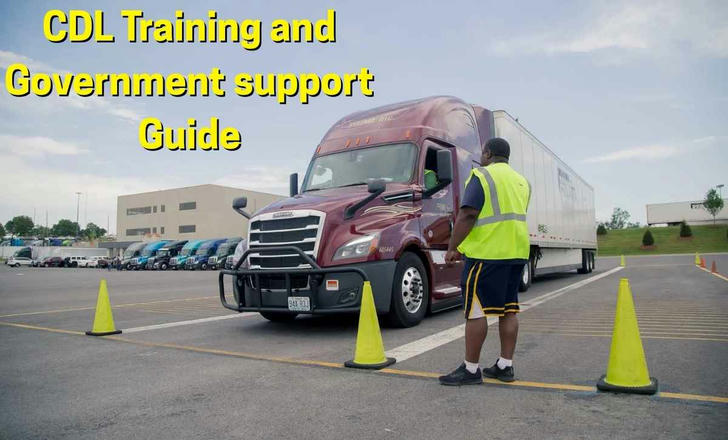The Complete Guide to CDL Training: Government-Supported Opportunities for Aspiring Drivers
CDL truck driver is becoming one of the most in-demand, high-paying technical professions. Government-supported CDL training programs guide beginners step by step, with flexible schedules and financial assistance, making it easier than ever to start a rewarding trucking career with minimal upfront costs.

Why CDL Training is Worth Considering?
Zero Experience? No Problem: Training begins with basic vehicle operation, traffic rules, and gradually builds confidence in handling large vehicles.
Financially Accessible: Government funding reduces tuition costs, making training achievable without significant personal expense.
Structured Learning: Classroom instruction, simulators, and on-road practice ensure readiness for the CDL exam.
Career Opportunities: CDL certification opens doors to local, regional, and long-haul trucking, and can lead to supervisor or specialized roles.
Flexible Schedule: Evening and weekend courses accommodate working adults or those with family responsibilities.
What CDL training programs are available?
| Program / School | Location | Highlights | Notes |
|---|---|---|---|
| Swift Academy | Multiple states | Class A CDL training, hands-on vehicle operation, safety and compliance courses | VA funding available for veterans |
| Schneider CDL Apprenticeship Training (CAT) | Nationwide | 5-week program, on-site training, driving practice, regulatory compliance | Government-aligned curriculum, partially funded |
| 160 Driving Academy | Nationwide | 150+ campuses, Class A CDL program, practical & theoretical training | Some state-supported spots available |
| Roadmaster Drivers School | Nationwide | Accelerated Class A CDL, simulator & on-road training | Financial aid available in certain states |
| Roehl Transport – Get Your CDL™ | Nationwide | Paid CDL training during program, career placement after certification | Government supporting may apply |
| Ivy Tech Community College | Indiana | FMCSA-compliant CDL training, ELDT-certified | State grants available for eligible students |
| Job Corps | Nationwide | Supported vocational training including CDL | Fully government-supported |
Entry Requirements: Most programs require applicants to be at least 18 years old for intrastate driving and 21 for interstate driving, have a valid driver’s license, and pass a basic background check and medical examination.
What are the Government Supports for CDL Training?
• WIOA (Workforce Innovation and Opportunity Act): Tuition assistance and career guidance for eligible participants via local workforce boards.
• TAA (Trade Adjustment Assistance): Funding for displaced workers affected by trade, supporting tuition and training costs.
• GI Bill®: Education benefits for veterans, applicable to CDL programs at VA-approved schools.
Common Questions About CDL Training (Q&A)
Q1: Can I enroll with no prior driving experience?
A: Yes. Programs start with basic skills and progress to advanced vehicle operation.
Q2: How long does it take to complete a CDL course?
A: Typically 3–12 weeks, depending on schedule and program intensity.
Q3: Can I train while working or managing family duties?
A: Flexible schedules including nights and weekends are common.
Q4: Will training prepare me for the CDL exam?
A: Yes. Programs include classroom learning, simulators, and on-road experience for exam readiness.
Q5: Are there job assistance after completing training?
A: Government-supported programs often provide career guidance and connections to local trucking companies.
How to Start Your CDL Training Journey?
• Check Eligibility: Ensure you meet age, license, and health requirements, and determine eligibility for government funding.
• Choose a Training Provider: Select a program that fits your schedule, location, and career goals.
• Prepare Documents: Gather ID, driver’s license, medical exam records, and any prior driving history documentation.
• Apply for Training & Funding: Submit applications to your chosen CDL school and government support programs if eligible.
• Complete Training: Attend classes, complete simulator and on-road practice, and pass any required exams.
• Start Your Career: Receive your CDL certification and begin working in the trucking industry.
Tips for Success
• Apply early for government-supported programs to secure funding.
• Consult program advisors or local workforce boards for guidance.
• Confirm that the course meets your state’s CDL requirements.
• Plan your schedule to balance training with work or personal responsibilities.
Summary:
Electrician training is accessible even for beginners, supported by government programs that reduce financial pressure and provide structured learning paths. With the right preparation and guidance, it is possible to gain essential skills, earn certification, and step into a stable and rewarding career.
